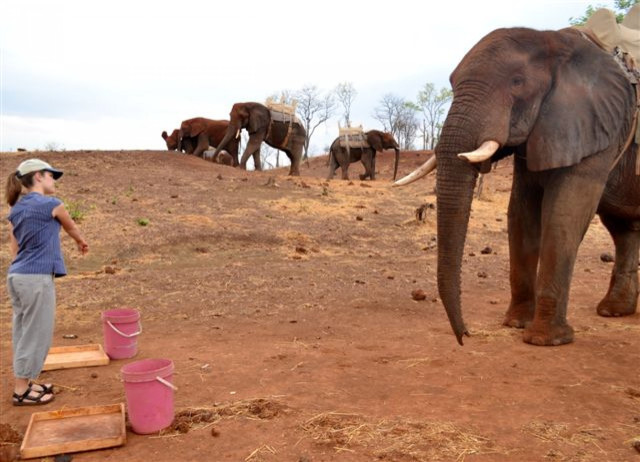Elephants Understand Pointing Gestures, Even Though Chimpanzees Do Not

If, for whatever reason, you need to get an elephant’s attention, you can probably just point. A new study shows that elephants can understand human pointing gestures -- an ability that sets them apart from other animals, like chimpanzees, that you would think would get the point of pointing, but don’t.
University of St. Andrews researchers Anna Smet and Richard Byrne recruited 11 captive elephants for their study, which was published on Thursday in the journal Current Biology. All of the animals belong to a safari company and are used to give rides to tourists near Victoria Falls in South Africa. While the elephants were trained to respond to voice commands, they had not been coached to understand pointing gestures.
In the researchers’ experiments, two buckets were placed before an elephant, with one containing food. An experimenter pointed at the bucket with food in it, and the researchers watched to see which bucket the elephant approached first. The perceptive pachyderms tended to follow the experimenter’s pointing arm to the food reward.
"What really surprised us is that they did not apparently need to learn anything,” Smet said in a statement. “Their understanding was as good on the first trial as the last, and we could find no sign of learning over the experiment."
The elephants could follow the experimenter’s pointed gesture to the right bucket even when her standing position was moved around (to make sure the elephants weren’t just picking the bucket she was closest to). And the elephants were generally not able to correctly choose the food bucket if the experimenter merely looked at the bucket without pointing at it.
“The most plausible account of our elephant’s ability to interpret even subtle human pointing gestures as communicative is that human pointing, as we presented it, taps into elephants’ natural communication system,” the authors wrote. “We suggest that the functional equivalent of pointing might take the form of referential indication with the trunk.”
Other studies have shown that dogs (and domestic cats, to an extent) also understand pointing gestures without training. In contrast, both chimpanzees and wolves fail pointing tests, even when experimenters try to train them. It makes sense that domestic animals, which have developed a dependence on humans for food, would be more attuned to human gestures than undomesticated animals. But elephants are not domesticated in the true sense of the word -- the elephants in this study, for example, forage for their own food when not giving rides to tourists. So why do they seem to have an innate understanding of pointing?
"What elephants share with humans is that they live in an elaborate and complex network in which support, empathy and help for others are critical for survival,” Byrne said in a statement. “It may be only in such a society that the ability to follow pointing has adaptive value, or, more generally, elephant society may have selected for an ability to understand when others are trying to communicate with them, and they are thus able to work out what pointing is about when they see it."
SOURCE: Smet and Byrne, “African Elephants Can Use Human Pointing Cues to Find Hidden Food.” Current Biology published online 10 October 2013.
© Copyright IBTimes 2024. All rights reserved.





















